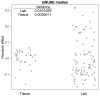Assessing affymetrix GeneChip microarray quality
- PMID: 21548974
- PMCID: PMC3097162
- DOI: 10.1186/1471-2105-12-137
Assessing affymetrix GeneChip microarray quality
Abstract
Background: Microarray technology has become a widely used tool in the biological sciences. Over the past decade, the number of users has grown exponentially, and with the number of applications and secondary data analyses rapidly increasing, we expect this rate to continue. Various initiatives such as the External RNA Control Consortium (ERCC) and the MicroArray Quality Control (MAQC) project have explored ways to provide standards for the technology. For microarrays to become generally accepted as a reliable technology, statistical methods for assessing quality will be an indispensable component; however, there remains a lack of consensus in both defining and measuring microarray quality.
Results: We begin by providing a precise definition of microarray quality and reviewing existing Affymetrix GeneChip quality metrics in light of this definition. We show that the best-performing metrics require multiple arrays to be assessed simultaneously. While such multi-array quality metrics are adequate for bench science, as microarrays begin to be used in clinical settings, single-array quality metrics will be indispensable. To this end, we define a single-array version of one of the best multi-array quality metrics and show that this metric performs as well as the best multi-array metrics. We then use this new quality metric to assess the quality of microarry data available via the Gene Expression Omnibus (GEO) using more than 22,000 Affymetrix HGU133a and HGU133plus2 arrays from 809 studies.
Conclusions: We find that approximately 10 percent of these publicly available arrays are of poor quality. Moreover, the quality of microarray measurements varies greatly from hybridization to hybridization, study to study, and lab to lab, with some experiments producing unusable data. Many of the concepts described here are applicable to other high-throughput technologies.
Figures






References
-
- Baker S, Bauer S, Beyer R, Brenton J, Bromley B, Burrill J, Causton H, Conley M, Elespuru R, Fero M, Foy C, Fuscoe J, Gao X, Gerhold D, Gilles P, Goodsaid F, Guo X, Hackett J, Hockett R, Ikonomi P, Irizarry R, Kawasaki E, Kaysser-Kranich T, Kerr K, Kiser G, Koch W, Lee K, Liu C, Liu Z, Lucas A. et al.The External RNA Controls Consortium: a progress report. Nature Methods. 2005;2:731–734. doi: 10.1038/nmeth1005-731. - DOI - PubMed
-
- Consortium M, Shi L, Reid L, Jones W, Shippy R, Warrington J, Baker S, Collins P, de Longueville F, Kawasaki E, Lee K, Luo Y, Sun Y, Willey J, Setterquist R, Fischer G, Tong W, Dragan Y, Dix D, Frueh F, Goodsaid F, Herman D, Jensen R, Johnson C, Lobenhofer E, Puri R, Schrf U, Thierry-Mieg J, Wang C, Wilson M. et al.The MicroArray Quality Control (MAQC) project shows inter-and intraplatform reproducibility of gene expression measurements. Nature Biotechnology. 2006;24:1151–1161. doi: 10.1038/nbt1239. - DOI - PMC - PubMed
-
- Shi L, Campbell G, Jones W, Campagne F, Wen Z, Walker S, Su Z, Chu T, Goodsaid F, Pusztai L, Shaughnessy JJ, Oberthuer A, Thomas R, Paules R, Fielden M, Barlogie B, Chen W, Du P, Fischer M, Furlanello C, Gallas B, Ge X, Megherbi D, Symmans W, Wang M, Zhang J, Bitter H, Brors B, Bushel P, Bylesjo M. et al.The MicroArray Quality Control (MAQC)-II study of common practices for the development and validation of microarray-based predictive models. Nature biotechnology. 2010;28(8):827. doi: 10.1038/nbt.1665. - DOI - PMC - PubMed
-
- American Society of Quality. http://asq.org/glossary/index.html
Publication types
MeSH terms
Substances
Grants and funding
LinkOut - more resources
Full Text Sources
Other Literature Sources
Miscellaneous

